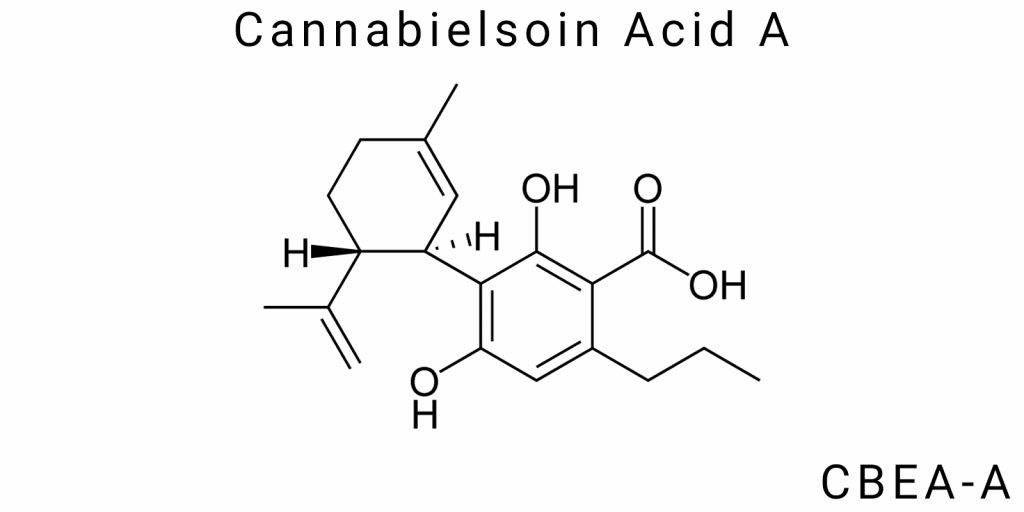Cannabielsoin Acid A (CBEA-A) is a relatively new compound within the context of cannabinoids, drawing attention from researchers due to its chemical uniqueness and potential therapeutic properties. It belongs to a group of cannabinoids found in plants of the Cannabis genus. Chemically, it is an acid that serves as a precursor to cannabielsoin, one of its primary functions being to participate in the synthesis of cannabinoids in plants. However, unlike more well-known cannabinoids such as THC or CBD, CBEA-A remains largely underexplored and is only beginning to attract scientific attention due to its interesting physiological effects and biological activity.
One of the main characteristics of CBEA-A is its chemical structure, which allows it to interact with cannabinoid receptors in the human and animal bodies. Since cannabinoids generally exert their activity by interacting with CB1 and CB2 receptors, there is a high likelihood that CBEA-A may also affect these systems, although its precise mechanisms of action are still not fully understood. However, it can already be hypothesized that, due to its chemical proximity to other cannabinoids, CBEA-A could have similar anti-inflammatory and neurotropic effects, opening up new possibilities for medical use.
In the scientific world, Cannabielsoin Acid A is currently perceived as a compound with significant potential for developing new medications, as there is limited understanding of its properties and mechanisms of action. Despite the limited number of studies, there are assumptions that this compound may be useful in treating a wide range of diseases, including chronic inflammatory processes, neurodegenerative diseases, and mental health disorders such as anxiety disorders or depression. However, further research is needed to confirm these hypotheses.
Chemical Structure of Cannabielsoin Acid A (CBEA-A)
Molecular Structure Description
Cannabielsoin Acid A (CBEA-A) is a carboxylated derivative of cannabielsoin, one of the cannabinoids found in plants of the Cannabis genus. Like most cannabinoids, CBEA-A has a complex organic molecule with several functional groups that define its chemical activity and biological properties. The CBEA-A molecule consists of a large number of carbon atoms, hydrogen, and oxygen, which is characteristic of many cannabinoids that contain carboxyl groups (-COOH).
The molecular structure of CBEA-A includes an aromatic benzene ring, which is part of a more complex organic structure, as well as an aliphatic chain portion, which may include extended links with double bonds. This gives the molecule unique characteristics, such as its ability to form stable interactions with various molecules in the body, promoting its biological activity. The presence of the acid group in the molecule also defines its reactivity, specifically its ability to bind with amine groups or other functional groups, allowing CBEA-A to interact with molecules within the body.
The composition of the CBEA-A molecule determines its ability to interact with various types of receptors, such as cannabinoid receptors type 1 (CB1) and type 2 (CB2), as well as other molecules in the nervous system, which contributes to its therapeutic effects. Importantly, CBEA-A is smaller in size compared to some other cannabinoids, such as THC, which could be an important factor for its penetration into the bloodstream and its ability to reach target tissues.
Common Characteristics with Other Cannabinoids
CBEA-A, like other cannabinoids, has a carbon-based structure, which is a common feature for most compounds in this group. Cannabinoids share a general structural characteristic: an aromatic ring that forms the foundation for their interaction with receptors in the body. This ring is a key structural element that allows cannabinoids to bind with cannabinoid receptors CB1 and CB2, which are part of the endocannabinoid system.
CBEA-A, like other cannabinoids, contains hydrophobic components, which facilitate its ability to pass through cellular membranes and interact with receptors located on the surface of cells. Furthermore, like most cannabinoids, CBEA-A can alter physiological processes, such as reducing inflammation, modulating pain sensations, and affecting the functions of the central nervous system.
An important common characteristic shared with other cannabinoids is the ability of CBEA-A to influence the cyclic adenosine monophosphate (cAMP) system, which is an important molecular mechanism for signal transduction within cells. Binding of cannabinoids to cannabinoid receptors can trigger a cascade of biochemical reactions that modify cell function and their interactions with one another. These molecular changes could form the basis for the therapeutic effects of CBEA-A, such as analgesia or anti-inflammatory actions.
Chemical Properties That Define CBEA-A’s Activity
Since CBEA-A is a carboxylated derivative of cannabielsoin, the chemical features of its molecule provide it with unique properties that define its biological activity. One important feature is the presence of a carboxyl group (-COOH), which makes the molecule water-soluble, allowing CBEA-A to be more readily absorbed and reach the bloodstream in the body. This also allows the compound to interact with molecules in hydrophilic environments, such as blood serum, which is important for its therapeutic effects.
Another significant chemical feature influencing CBEA-A’s activity is its ability to engage in hydrophobic interactions with cannabinoid receptors. Since cannabinoid receptors (CB1 and CB2) have hydrophobic regions, cannabinoid molecules, including CBEA-A, can efficiently interact with them, which ensures its biological activity. The structural and size differences of CBEA-A compared to other cannabinoids, such as THC, give it specific properties that may make it useful for therapeutic applications without triggering the psychoactive effects typical of other cannabinoids.
Chemical changes that occur in the body after the administration of CBEA-A can vary depending on its interaction with receptors. For example, binding to CB2 receptors could cause anti-inflammatory effects, while interaction with CB1 could alter neurotransmission, which has implications for treating neurological disorders. Molecular activity of CBEA-A could also change the levels of certain neurotransmitters, such as dopamine or serotonin, which is important for treating depression, anxiety disorders, and pain.
Given these chemical properties, CBEA-A, like other cannabinoids, could become a foundation for new therapeutic agents that reduce the risk of side effects when treating various diseases. However, further studies are needed to fully understand its effectiveness and explore its impact on the body at the molecular level.
Biogenesis and Origin of Cannabielsoin Acid A (CBEA-A)
Sources of CBEA-A in Nature
Cannabielsoin Acid A (CBEA-A) is a naturally occurring compound found in plants of the Cannabis genus and is a derivative of cannabielsoin. Its formation in nature occurs through biochemical processes involving the enzymatic conversion of precursors. CBEA-A is one of the numerous cannabinoids synthesized in Cannabis tissues under the influence of specific enzymes that facilitate the chemical transformations of molecules.
The primary site of CBEA-A synthesis is various parts of the Cannabis plant, particularly the leaves, flowers, and other active plant parts. These tissues contain specialized cells known as trichomes, which produce cannabinoids. The synthesis process of CBEA-A is closely linked to the cannabinoid biosynthesis pathways in plants. The primary precursor for CBEA-A is cannabielsoin (CBE), which, under the influence of enzymes, such as cannabielsoin oxidase, is converted into its acidic form-cannabielsoin Acid A. This molecular transformation is part of a complex process in which metabolic pathways are activated within the plant to produce biologically active compounds.
The natural biosynthesis of CBEA-A in Cannabis results from the complex interaction of genetic factors, ecological conditions, and enzyme activity. Since cannabinoid synthesis is highly sensitive to external conditions, such as temperature, humidity, light levels, and other environmental factors, the level of CBEA-A production can vary depending on the growing environment. Some studies show that under certain cultivation conditions, the production of CBEA-A can be significantly higher, which increases interest in these cannabinoids for the pharmaceutical industry and medical applications.
Biosynthesis in Cannabis Plants
The biosynthesis of CBEA-A in Cannabis plants is a complex, multi-step process dependent on various enzymatic reactions. As with most cannabinoids, the synthesis of CBEA-A begins with the formation of cannabigerolic acid, which is the precursor for most cannabinoids. This compound is then converted into tetrahydrocannabinol (THC) or cannabidiol (CBD) through the action of specific enzymes activated during biosynthesis.
An important step in the biosynthesis of CBEA-A is the enzymatic conversion of cannabielsoin (CBE), which occurs through the activation of cannabielsoin oxidase. This enzyme oxidizes cannabielsoin to form cannabielsoin Acid A. This transformation of the compound into its acidic form is a crucial step in the Cannabis plant’s metabolism, which ensures the production of various cannabinoids, each with its distinct physiological properties.
These biochemical processes in Cannabis plants are also influenced by the genetic specification of different strains, as some strains are more efficient at synthesizing CBEA-A, while others may have lower levels of this compound. This is one of the reasons why studying the biosynthesis of CBEA-A has become increasingly important-particularly for cultivating specific plant strains for medical purposes, where the concentration of this cannabinoid may be crucial.
Similarities and Differences with Other Natural Cannabinoids
CBEA-A, like most cannabinoids, belongs to a group of phenolic compounds synthesized by Cannabis plants through complex biochemical processes. It shares similarities with other cannabinoids in terms of structure and synthesis, but it also has unique features that define its distinct properties.
One of the main similarities between CBEA-A and other cannabinoids is the presence of a phenolic ring in its structure, which is a common characteristic of most cannabinoids such as THC (Δ9-tetrahydrocannabinol) and CBD (cannabidiol). This ring serves as an active site for interactions with cannabinoid receptors CB1 and CB2, allowing CBEA-A to potentially affect the nervous system and other body systems.
However, the differences between CBEA-A and other cannabinoids begin with its molecular mass and functional groups. CBEA-A contains a carboxyl group (-COOH), which makes it water-soluble, while other cannabinoids, such as THC, are hydrophobic due to the absence of a carboxyl group. This gives CBEA-A unique properties, including the ability for more efficient absorption in the body, as well as altering its solubility in biological fluids.
Another significant distinction is that CBEA-A does not have psychoactive properties, unlike THC, which makes it suitable for therapeutic use without the risk of side effects associated with psychoactive effects. This sets CBEA-A apart from THC, the most well-known and widely studied cannabinoid, and makes it more attractive for medical applications.
Moreover, CBEA-A may have a more pronounced anti-inflammatory and neuroprotective activity, which makes it a promising candidate for treating chronic inflammatory diseases, such as arthritis, and neurological disorders, such as Alzheimer’s disease or multiple sclerosis. Its chemical structure, compared to other cannabinoids, may also determine its unique impact on neurotropic receptors and microglia, which is an important aspect of studying its therapeutic potential.
Methods of Manufacturing Cannabielsoin Acid A (CBEA-A)
Overview of Synthesis and Extraction Methods
The production of Cannabielsoin Acid A (CBEA-A) involves several methods, varying depending on the desired product type, purity level, and efficiency. Since CBEA-A is a naturally occurring cannabinoid, there are both traditional and modern technologies available for its synthesis or extraction from plants. The main methods of production include:
- Extraction from Cannabis Plants:
Extraction is the most common method for obtaining cannabinoids, including CBEA-A. Since CBEA-A occurs in small concentrations in nature, the extraction process requires high-quality methods, such as the use of organic solvents (methanol, ethanol, hexane) or supercritical CO2 extraction to achieve high efficiency. CO2 extraction is a modern technique that produces extracts with high purity, free from solvent residues.
- Synthesis from Cannabielsoin (CBE):
Cannabielsoin Acid A (CBEA-A) is a derivative of cannabielsoin (CBE). This allows for the use of CBE as a starting compound for the synthesis of CBEA-A through an enzymatic oxidation reaction. The enzymatic process involves the oxidation of CBE by cannabielsoinoxydase, which catalyzes the conversion of CBE into Cannabielsoin Acid A.
- Chemical Synthesis Methods:
CBEA-A can also be obtained using chemical synthesis methods. Typically, this involves specific reactions, such as oxidation, where CBE or other precursors are treated with oxidizing agents in the presence of catalytic amounts of organic or inorganic compounds. This synthesis may be useful for laboratory research but is less efficient for industrial production due to the need for precise control over the reaction conditions.
- Use of Plant Cell Cultures:
New approaches to CBEA-A synthesis include the use of Cannabis cell cultures, allowing for cannabinoid production under conditions similar to natural growth without the need to grow large plants. These culture-based methods are promising as they allow for controlled growth conditions, leading to high-yield production of CBEA-A without a loss in efficiency.
Biotechnological Production Methods
Biotechnological production methods represent advanced technologies that allow for much larger scale production of CBEA-A compared to traditional methods. These include:
- Genetically Modified Organisms (GMO):
One of the most promising directions involves the use of genetically modified microorganisms or plants to synthesize CBEA-A. Since CBE is a precursor to CBEA-A, using genetically modified bacteria or yeast to express specific cannabinoid biosynthetic pathways enables higher efficiency and purity in CBEA-A production. Using such microorganisms allows for large-scale synthesis of the compound at comparatively low raw material costs.
- Plant Biotechnology:
Most cannabinoids, including CBEA-A, are naturally produced in Cannabis plants. However, to enhance production efficiency, plant biotechnology methods such as transgenic plants or cell cultures can be used. Introducing specific genes that encode enzymes involved in cannabinoid biosynthesis allows for increased CBEA-A production in plants. This method has several advantages, including reduced cultivation costs and stable product yields.
- Genetic Engineering Methods to Induce CBEA-A Synthesis:
The development of genetic engineering strategies to stimulate CBEA-A synthesis is a promising area for biotechnological industries. These strategies involve introducing genes encoding enzymes responsible for CBEA-A biosynthesis into microorganisms or plant cultures, which increases the production of this compound in both laboratory and industrial conditions. Such methods could replace traditional extraction techniques, which may be less efficient and require large amounts of plant raw material.
- Bioreactor Production Methods:
Bioreactors are used for large-scale cultivation of cells or microorganisms that can synthesize CBEA-A. In this method, cells produce the required compound under controlled conditions (temperature, pH, oxygen level). This is one of the most efficient mass-production techniques as it significantly increases production efficiency and reduces raw material costs.
Comparison of Traditional and Modern Technologies
The choice of manufacturing methods for CBEA-A depends on various factors, such as efficiency, raw material costs, and energy resources, as well as the production goals-whether for research purposes or large-scale industrial production.
- Traditional Methods:
Traditional methods, such as plant extraction or chemical synthesis, are well-known and relatively effective for obtaining CBEA-A, particularly when working with limited quantities of the product. However, they have several drawbacks, including low efficiency, high raw material requirements, and the need for complex conditions to ensure product purity. In extraction processes using organic solvents, there is a risk of contamination of the final product with solvent residues, which can impact product safety.
- Modern Technologies:
Modern methods, including biotechnological and genetic engineering technologies, significantly improve the efficiency of CBEA-A production, reducing raw material costs and improving control over the production process. The use of genetically modified microorganisms, transgenic plants, and bioreactors allows for the production of CBEA-A in much larger quantities and with higher purity. These methods also reduce reliance on natural resources and enable production in more controlled environments, which is essential for obtaining high-quality and standardized products.
- Development Prospects:
The application of biotechnology and genetic modifications in the future could lead to the development of more efficient and environmentally friendly production methods for CBEA-A. As the demand for cannabinoids increases, particularly in the medical and pharmaceutical sectors, modern technologies could significantly reduce production costs, making CBEA-A more accessible for widespread use.
Biological Activity and Mechanisms of Action of Cannabielsoin Acid A (CBEA-A)
Receptor Actions and Mechanisms of Biological Activity
Cannabielsoin acid A (CBEA-A) is a cannabinoid compound with unique mechanisms of action on receptors in the body. Like other cannabinoids, it interacts with the endocannabinoid system (ECS), which includes CB1 and CB2 receptors, as well as numerous other molecular targets such as ion channels, enzymes, and secondary messengers. CBEA-A influences these receptors through complex mechanisms, including modulation of neurotransmission, altering cellular activity, and regulating immune responses.
- Cannabinoid Receptors: CBEA-A, like other cannabinoids, acts on the two main types of receptors in the endocannabinoid system: CB1 and CB2. CB1 receptors are primarily located in the central nervous system (CNS), particularly in the brain and spinal cord. They regulate neurotransmission and influence functions such as pain, memory, mood, motor activity, and other physiological processes. CB2 receptors are mainly found in peripheral tissues, especially in immune cells such as macrophages, and in other tissues involved in inflammatory processes. These receptors participate in regulating immune responses and can influence the reduction of inflammation, pain signal modulation, and other essential processes. As a cannabinoid, CBEA-A has the ability to modulate these receptors, showing both agonistic and antagonistic activity depending on the context.
- Other Molecular Targets: In addition to cannabinoid receptors, CBEA-A may interact with other molecular targets. One such target is the TRPV receptor (temperature and pain channels), which plays a crucial role in regulating pain and temperature sensations. Cannabinoids can interact with TRPV receptors, which may lead to a reduction in pain, particularly in chronic pain conditions. CBEA-A demonstrates the ability to alter the activity of these channels, making it potentially useful for analgesia. Furthermore, CBEA-A may influence signaling molecules and enzymes such as cyclic adenosine monophosphate (cAMP) and adenylate cyclase, which are involved in regulating cellular activity and homeostasis.
Effects on the Central Nervous System
The central nervous system (CNS) is one of the primary targets for cannabinoid action, and CBEA-A is no exception. It has the ability to influence brain and nervous system functions, manifested in its potential psychotropic and neuroprotective properties.
- Neuroprotection: One of the primary benefits of CBEA-A is its ability to provide a neuroprotective effect, which is crucial for protecting neurons from damage associated with neurodegenerative diseases. CBEA-A can reduce oxidative stress and inflammatory processes in nerve cells. It decreases the levels of pro-oxidant molecules, such as reactive oxygen species (ROS), which are major factors leading to neuronal degradation. This offers its potential in treating diseases like Alzheimer’s disease, Parkinson’s disease, and other neurodegenerative conditions.
- Reduction of Anxiety and Stress: Cannabielsoin acid A may also have an anti-stress effect by influencing the hypothalamic-pituitary-adrenal (HPA) axis. This results in a reduction in cortisol levels – the stress hormone – which, in turn, diminishes feelings of anxiety and depression. This effect is observed through CBEA-A’s interaction with CB1 receptors in the brain, which help reduce neurotransmitters like glutamate that elevate anxiety levels.
- Modulation of Neurotransmission: CBEA-A can also affect neurotransmission in the CNS, specifically the levels of dopamine, serotonin, and other neurotransmitters that regulate mood, behavior, and cognitive functions. This can influence the body’s ability to adapt to stressful situations and maintain cognitive functions. The interaction of CBEA-A with cannabinoid receptors in the CNS may result in mild modulation of neurotransmission, helping to maintain equilibrium in the nervous system.
Anti-inflammatory and Neurotropic Effects
Beyond its effects on the nervous system, CBEA-A demonstrates potent anti-inflammatory and neurotropic properties, making it a promising candidate for treating inflammatory and degenerative diseases.
- Anti-inflammatory Effects: One of the essential mechanisms of action of CBEA-A is its ability to reduce inflammation in the body. This occurs through the reduction of pro-inflammatory cytokine production, such as TNF-α, IL-1β, and IL-6, which are characteristic of autoimmune and inflammatory diseases. CBEA-A influences immune cells, particularly macrophages and neutrophils, allowing it to reduce inflammatory processes. These properties may be used in the treatment of diseases like arthritis, colitis, and other chronic inflammatory conditions.
- Neurotropic Effects: Cannabielsoin acid A also possesses neurotropic properties, which manifest in its ability to alter neuronal activity. It may stimulate neurogenesis, particularly in the hippocampus – the area of the brain responsible for memory and learning. This is especially important in recovery after brain injuries, as well as in the treatment of diseases that lead to the loss of neurons, such as Alzheimer’s disease.
- Modulation of Oxidative Processes: CBEA-A demonstrates strong antioxidant properties that help reduce oxidative processes in the body. This is crucial not only for protecting nerve cells from damage but also for overall health. Oxidative stress is a primary factor in the development of many chronic diseases, and CBEA-A’s ability to reduce this stress may serve as the basis for creating new treatment approaches.
Medical Significance and Applications of Cannabielsoin Acid A (CBEA-A)
Cannabielsoin Acid A (CBEA-A), as one of the cannabinoids, holds significant therapeutic potential in various medical fields, including the treatment of neuropathies, inflammatory diseases, mental disorders, and cancer. As this compound interacts with the endocannabinoid system and other biological targets, it possesses a range of effects that open up new possibilities for its use in medicine.
Potential of CBEA-A in Treating Neuropathies and Inflammatory Diseases
Like many other cannabinoids, CBEA-A has demonstrated the ability to reduce pain associated with neuropathy by modulating neurotransmission in the central nervous system. Neuropathies are disorders characterized by nerve damage, leading to persistent or intermittent pain. One of the important mechanisms of CBEA-A’s action is its ability to influence CB1 and CB2 receptors, which regulate pain sensitivity and inflammatory responses. Its impact on CB1 receptors can reduce the transmission of pain signals in the central nervous system, while activation of CB2 receptors results in reduced inflammation in peripheral tissues.
Particularly important is CBEA-A’s potential in treating chronic pain resulting from nerve injuries or conditions such as diabetic neuropathy, post-herpetic neuralgia, and chronic lower back pain. The use of CBEA-A in such cases significantly reduces pain intensity and improves the overall condition of patients. Additionally, CBEA-A has anti-inflammatory properties that help alleviate inflammation in nerve tissue, which is also a key aspect of neuropathy treatment.
It also shows activity against autoimmune inflammatory diseases such as osteoarthritis, Crohn’s disease, and immune disorders related to excessive immune system activation. By modulating the activity of T lymphocytes and macrophages, CBEA-A can significantly reduce levels of inflammatory cytokines and chemokines, helping control autoimmune reactions and decrease tissue damage.
Use in Treating Mental Disorders
CBEA-A also holds promise in the treatment of mental health disorders such as anxiety disorders, depression, stress, post-traumatic stress disorder (PTSD), and as part of a combination therapy for schizophrenia. The endocannabinoid system plays a crucial role in regulating mood, emotional states, and stress responses, and cannabinoids, including CBEA-A, can interact with these mechanisms.
One of the main mechanisms through which CBEA-A affects mental health is its ability to modulate CB1 receptor activity in the central nervous system. This helps reduce anxiety, improve mood, and alleviate symptoms of depression. Since changes in neurotransmitters like serotonin and dopamine occur in mental health disorders, CBEA-A can normalize their levels, thus improving emotional stability in patients.
This compound can be beneficial for patients suffering from chronic stress, anxiety, and depression, as well as for treating symptoms associated with psychoses, such as sleep disturbances, intrusive thoughts, and loss of motivation. Its interaction with CB2 receptors also allows CBEA-A to reduce inflammation in the brain, which may be an important factor in treating mental health conditions such as depression and schizophrenia.
Research on Efficacy in Treating Cancer and Other Diseases
One of the most promising directions for studying CBEA-A is its potential in cancer treatment. Cannabinoids, including CBEA-A, can influence various molecular pathways that regulate the growth and differentiation of cancer cells. Some studies show that CBEA-A may inhibit cancer cell growth, induce apoptosis (programmed cell death), and limit metastasis.
CBEA-A’s mechanism of action in oncology includes activation of CB2 receptors, which helps reduce the invasiveness of cancer cells, as well as activation of other molecules related to apoptosis regulation. This process could be particularly useful in fighting tumors that are resistant to conventional treatments. Another important aspect is CBEA-A’s effect on reducing pain in cancer patients, as it can alleviate symptoms, decreasing the need for powerful painkillers that may have serious side effects.
CBEA-A also shows potential in treating other chronic diseases such as cardiovascular diseases. Its anti-inflammatory properties can help reduce the risk of developing atherosclerosis by lowering oxidative stress and the inflammatory process in blood vessel walls. There is also evidence that CBEA-A may be useful in treating metabolic syndrome by helping normalize blood sugar levels and improving insulin sensitivity.
Ecological and Ethical Aspects of Using Cannabielsoin A Acid (CBEA-A)
Given the growing interest in cannabinoids as medicinal substances, ecological and ethical concerns regarding their use are becoming increasingly relevant. Specifically, Cannabielsoin A (CBEA-A), as one of the compounds in this class, contributes to these discussions due to its production and use being linked to cannabis cultivation as a raw material and specific technological processes. To assess the impact of CBEA-A on the environment and society, it is essential to consider aspects such as the ecological consequences of cannabis cultivation, ethical issues related to its use, and regulatory matters at the level of international legislation.
Impact on the Environment
The cultivation of cannabis for the production of cannabinoids, including CBEA-A, has a significant ecological impact. One of the primary concerns is the use of water and land resources for growing this plant. Cannabis requires a large amount of water, particularly in intensive industrial cultivation, which can lead to the depletion of water resources, especially in regions with water scarcity. Additionally, large-scale cannabis cultivation can result in landscape changes and reduced biodiversity since monocultures are often used, which are less resistant to diseases and pests.
Another issue is the use of pesticides and chemical fertilizers to protect plants and stimulate their growth. Improper or excessive use of such chemicals can contaminate soils and waters, posing a threat to the environment and human health. A particularly critical problem is the contamination with heavy metals, as cannabis has the ability to accumulate toxic substances from the soil. This is especially dangerous if plants are grown in areas with polluted soil or water.
Energy consumption associated with cannabis cultivation should also be taken into account. For instance, the intensive use of greenhouses with artificial lighting and temperature control requires substantial energy input, increasing the carbon footprint of cannabinoid production. In light of these factors, it is crucial to explore more ecological methods of cannabis cultivation, such as organic farming or the use of renewable energy sources to reduce the environmental impact.
Ethical Issues in Cannabis Cultivation and Cannabinoid Production
The cultivation of cannabis for the production of cannabinoids, including CBEA-A, is also associated with a number of ethical concerns. One important aspect is the regulation of the cultivation and harvesting process in terms of social responsibility. Issues related to labor practices in this industry are vital for ensuring fair working conditions for farmers and workers. Cannabis cultivation can be linked to the use of unauthorized labor or low wages, raising ethical questions about such practices. Additionally, there are concerns regarding equitable access to resources for small farmers versus large corporations producing cannabinoids on an industrial scale.
Another crucial ethical issue concerns the use of cannabis for medicinal purposes. While scientific research demonstrates the great potential of cannabinoids, particularly CBEA-A, in treating a range of diseases, questions arise about the accessibility of these substances for all segments of the population. The cost of cannabinoid-based treatments can be substantial, which threatens equality in access to healthcare services. This is particularly relevant for low-income individuals, potentially leading to social inequality in treatment.
It is also important to address the ethical aspects of using cannabis as a recreational drug. While some countries have legalized cannabis for personal use, this remains a controversial issue at the international level. Legislative initiatives to legalize cannabis, particularly for medical purposes, face ethical inquiries, such as whether it is appropriate to use narcotic substances in medicine or if this could lead to abuse.
Regulation of Cannabinoid Use in Different Countries
From a regulatory standpoint, the use of cannabinoids, including CBEA-A, is subject to various legislative initiatives in different countries. It is important to understand that the regulation of this field varies depending on national policies and cultural specifics. In some countries, such as Canada and several U.S. states, medical use of cannabinoids has been legalized, allowing patients to receive therapeutic benefits from substances like CBEA-A. However, in other countries, particularly in many Arab nations and some parts of Asia, the use of cannabinoids remains prohibited, and even for medical purposes, these substances are often not available.
From the perspective of international organizations such as the UN and WHO, the legalization of cannabinoids is a subject of ongoing debate. WHO recognizes the potential of cannabinoids in treating various diseases but simultaneously emphasizes the need for control over their use to avoid abuse and the unauthorized spread of drugs.
Legislative initiatives regarding cannabinoids are often accompanied by concerns about safety and efficacy. Countries that legalize medical cannabinoids typically require clinical studies and government approval of products before they can be used. This is an important aspect, as although many cannabinoids have demonstrated effectiveness in treating a range of diseases, further research is needed to confirm their safety and appropriate dosages.
Prospects for Research and Future of Cannabielsoin A Acid (CBEA-A)
Cannabielsoin A (CBEA-A), as a relatively new compound within the cannabinoid group, has garnered attention from researchers due to its multifaceted potential in treating various diseases, as well as its possible applications in biotechnology and pharmaceuticals. However, despite numerous promises, many aspects still require in-depth research, both in terms of the chemical nature of CBEA-A and its therapeutic effects. This article explores the prospects for research and the future of CBEA-A, specifically new research directions, the need for the development of technologies and methods, as well as the potential for creating new therapeutic agents based on CBEA-A.
New Research Directions
One of the most promising research directions for CBEA-A is its impact on cellular mechanisms, which could pave the way for new therapeutic approaches to treating not only inflammatory and neurodegenerative diseases but also more complex chronic illnesses. For example, studies related to the antagonism of CBEA-A on CB1 and CB2 receptors open up new possibilities for developing drugs to treat chronic pain associated with disrupted pain sensitivity and neurogenic disorders. Existing scientific works suggest that cannabinoids can modulate gene expression mechanisms involved in the development of neurotrophic disorders and inflammatory processes. The prospects for studying CBEA-A in this context lie in uncovering the mechanisms through which this cannabinoid may reduce neuropathy and improve the functional activity of nerve cells.
In addition, another key direction is studying the effect of CBEA-A on mitochondrial function and cellular metabolism. Since mitochondria are critical organelles for maintaining cellular energy and regulating apoptosis, research focusing on their connection with cannabinoids could help develop new therapeutic strategies for treating diseases such as diabetes, cardiovascular diseases, and cancer. Research in this area requires a detailed understanding of the mechanisms by which CBEA-A affects oxidative stress and the antioxidant properties of cells.
Equally important is the direction involving the study of CBEA-A’s effect on the immune system. In particular, there is significant interest in the role of cannabinoids in regulating immune cells, such as T lymphocytes and macrophages, which actively participate in inflammatory processes. Considering the ability of cannabinoids to influence physiological processes through CB2 receptors, studying the interaction of CBEA-A with these cells could offer new approaches to treating autoimmune diseases and mitigating systemic inflammation.
Given these directions, research on CBEA-A in the context of personalized medicine is crucial, which requires a deeper understanding of the genetic variations that may affect the efficacy and safety of cannabinoid therapies. Personalized treatment based on biomarker studies opens up the potential for applying CBEA-A in therapy, particularly among patients with different genetic predispositions and health risks.
Need for Further Development of Technologies and Methods
Given the complexity of the CBEA-A structure and the need for ensuring highly purified samples for research and therapy, one of the key aspects of advancing science is improving the technologies for synthesizing and isolating this cannabinoid. Methods for synthesizing CBEA-A using organic and biochemical platforms have significant potential to reduce costs for obtaining pure substances in industrial quantities, which is an important factor for creating affordable medications. At the same time, effective methods of extraction and purification of CBEA-A from cannabis plants need to be developed to ensure high purity without toxic impurities.
In this regard, the further development of biotechnological methods based on genetic engineering, including the synthesis of CBEA-A using microorganisms or plants, opens up opportunities for more sustainable and environmentally friendly production processes. For example, using synthetic biological systems based on yeast or bacteria for cannabinoid production allows for the creation of more efficient and stable methods that are not dependent on external factors such as climate change or soil quality.
Also important is the development of new methods for studying the pharmacokinetics and pharmacodynamics of CBEA-A. For this, highly sensitive techniques are required to accurately measure cannabinoid concentrations in biological fluids such as blood, urine, and other tissues, as well as determine their interaction with the body at the molecular level. Modern mass spectrometry technologies, as well as the use of nanotechnologies to develop new nanoparticles for delivering cannabinoids to target organs, hold great potential in this direction.
For studies related to the efficacy of cannabinoids in clinical settings, new methods of studying in real-life conditions are necessary. This includes multi-level clinical trials in which different aspects of CBEA-A application in specific pathologies, dosing, therapy duration, and interaction with other drugs will be evaluated.
Potential for Creating New Therapeutic Agents Based on CBEA-A
One of the greatest promises of CBEA-A is its potential for creating new therapeutic agents to treat a wide range of diseases. Existing data on the efficacy of cannabinoids in treating pain, inflammation, and nervous system disorders open up possibilities for creating new medical drugs based on CBEA-A.
Given CBEA-A’s ability to modulate CB1 and CB2 receptors, this cannabinoid has the potential for developing drugs not only for chronic pain and inflammatory processes but also for treating conditions such as bipolar disorder, depression, post-traumatic stress disorder (PTSD), and for reducing symptoms associated with neurodegenerative diseases like Alzheimer’s and Parkinson’s disease.
Another promising area is the use of CBEA-A in oncology, particularly in the development of drugs that could block the growth of cancer cells or reduce the side effects of chemotherapy, such as nausea, pain, and loss of appetite. Cannabinoids have already shown their effectiveness in this area, and CBEA-A has the potential to become part of future therapeutic strategies for treating oncological diseases.
Furthermore, the development of personalized medicine, considering the genetic characteristics of patients, opens up new opportunities for optimizing therapy based on CBEA-A, which will help enhance its effectiveness and reduce side effects. Considering individual variations in cannabinoid metabolism, in the future, the development of personalized therapeutic approaches using CBEA-A will be an important direction in clinical practice.
Overall, the potential of Cannabielsoin A (CBEA-A) as a therapeutic agent is significant, and future research could greatly expand its medical applications. The development of new technologies and synthesis methods, as well as advances in pharmacological studies and the personalization of therapy, create the foundation for the effective implementation of this cannabinoid in medical practice.
Conclusion
Cannabielsoin A (CBEA-A) is a promising cannabinoid with numerous potential applications in medicine and biotechnology. Its properties, including anti-inflammatory, neuroprotective, and analgesic effects, open up broad possibilities for treating conditions such as neuropathies, mental disorders, as well as for addressing chronic pain and inflammatory processes. However, in order to realize this potential, further research is needed to not only gain a deeper understanding of its molecular mechanisms of action but also to develop effective technologies for its synthesis and clinical application.
Key areas for future research on CBEA-A include the development of new synthesis methods that will ensure high purity of the cannabinoid, as well as the improvement of pharmacological studies to more accurately determine effective doses and drug delivery methods. Specifically, researchers should focus on the development of personalized treatment technologies that take into account genetic and metabolic characteristics of patients.
Moreover, despite its significant potential, ecological and ethical issues related to cannabis cultivation and cannabinoid production remain important aspects that must be addressed when introducing new therapeutic agents. Regulation and legislation concerning the use of cannabinoids in various countries need further changes to ensure the safety and accessibility of medicinal products.
Sources:
- PubMed (National Library of Medicine) https://pubmed.ncbi.nlm.nih.gov
PubMed is one of the largest databases of scientific publications in the field of medicine and biomedicine. It provides access to studies not only on cannabinoids but also on more specific molecules, such as CBEA-A. - National Institute on Drug Abuse (NIDA) https://www.drugabuse.gov
NIDA publishes up-to-date scientific articles and reviews on the effects of cannabinoids on health, as well as new directions in the study of the medicinal properties of cannabis. - The Journal of Clinical Investigation https://www.jci.org
This journal publishes high-quality scientific articles, including those related to the therapeutic use of cannabinoids and other bioactive compounds. - Frontiers in Pharmacology https://www.frontiersin.org/journals/pharmacology
A publishing platform that provides peer-reviewed scientific articles across a wide range of disciplines, including cannabinoid pharmacology and the molecular mechanisms of their action. - The British Journal of Pharmacology https://bpspubs.onlinelibrary.wiley.com/journal/14765381
This journal specializes in pharmacological publications and features a large archive of articles on cannabinoids and their pharmacological properties. - Cannabis and Cannabinoid Research https://www.liebertpub.com/can
A specialized journal that covers the latest advancements in cannabinoid research and their medical applications. - National Institutes of Health (NIH) https://www.nih.gov
The official NIH website provides access to numerous studies funded by government institutions, including topics related to cannabinoids.






